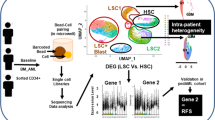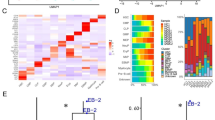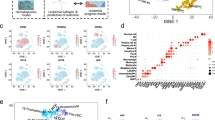Abstract
Fanconi anemia (FA) is the predominant hereditary syndrome of bone marrow failure (BMF), distinguished by impairments in DNA repair mechanisms. The deficiency in the FANC pathway, which governs DNA repair and replication rescue, results in aberrant responses to DNA damage in individuals with FA. The objective of this study is to examine the involvement of the FANC core complex in BMF and ascertain nucleolar homeostasis-related genes by conducting transcriptome analysis on primary hematopoietic stem cells obtained from FA patients with FANCA and FANCC variants. In the present study, we analyzed scRNA-seq data obtained from both healthy donors and individuals diagnosed with FA in order to investigate the phenomenon of cell–cell communication. Through the implementation of trajectory analysis, the differentiation pathways of several progenitor cell types, such as HSC cells transitioning into LMPP, N, M, B-prog, and E cells, were elucidated. Moreover, by scrutinizing the inferred interactions, notable disparities in cell–cell communication were observed between FA patients and their healthy counterparts. Our analysis has unveiled heightened interactions involving TNFSF13B, MIF, IL16, and COL4A2 in patients with FA. Furthermore, we have developed a prognostic model for predicting the outcome of acute myeloid leukemia (AML) which has exhibited remarkable predictive precision, with an AUC exceeding 0.83 at the 3- and 5-year intervals following the baseline assessment. In summary, the prognostic model that has been developed provides a valuable instrument for forecasting outcomes of AML by utilizing the genes identified through both single-cell and bulk transcriptome analyses.




Similar content being viewed by others
Data Availability
The NCBI Gene Expression Omnibus (GEO: GSE157591) provides single-cell sequencing data.
Abbreviations
- AML:
-
Acute myeloid leukemia
- B-prog:
-
B cells progenitor
- E:
-
Erythroid progenitor
- EMP:
-
Erythroid–megakaryocyte progenitor
- FA:
-
Fanconi anemia
- FDR:
-
False discovery rate
- BMF:
-
Bone marrow failure
- HC:
-
Healthy donors
- HSPCs:
-
Hematopoietic stem and progenitor cells
- HSCs:
-
Hematopoietic stem cells
- LMPP:
-
Lymphoid-primed multipotent progenitor
- M:
-
Monocyte progenitor
- MK:
-
Megakaryocyte progenitor
- MK/E:
-
Common megakaryocyte/erythroid cluster
- N:
-
Neutrophil progenitor
- PA:
-
Patients with FA
- UMAP:
-
Uniform manifold approximation and projection
References
Alban TJ, Bayik D, Otvos B, Rabljenovic A, Leng L, Jia-Shiun L, Roversi G, Lauko A, Momin AA, Mohammadi AM, Peereboom DM, Ahluwalia MS, Matsuda K, Yun K, Bucala R, Vogelbaum MA, Lathia JD (2020) Glioblastoma myeloid-derived suppressor cell subsets express differential macrophage migration inhibitory factor receptor profiles that can be targeted to reduce immune suppression. Front Immunol 11:1191. https://doi.org/10.3389/fimmu.2020.01191
Arima N, Nakamura F, Yabe T, Tanaka J, Fuji S, Ohashi K, Fukuda T, Miyamura K, Iwato K, Eto T, Mori T, Kobayashi N, Hoshino T, Kato C, Kanamori H, Nakamae H, Atsuta Y, Morishima Y, Kanda Y (2016) Influence of differently licensed KIR2DL1-positive natural killer cells in transplant recipients with acute leukemia: a japanese national registry study. Biol Blood Marrow Transplant 22(3):423–431. https://doi.org/10.1016/j.bbmt.2015.09.029
Cao J, Spielmann M, Qiu X, Huang X, Ibrahim DM, Hill AJ, Zhang F, Mundlos S, Christiansen L, Steemers FJ, Trapnell C, Shendure J (2019) The single-cell transcriptional landscape of mammalian organogenesis. Nature 566(7745):496–502. https://doi.org/10.1038/s41586-019-0969-x
Chen D, Enroth S, Ivansson E, Gyllensten U (2014) Pathway analysis of cervical cancer genome-wide association study highlights the MHC region and pathways involved in response to infection. Hum Mol Genet 23(22):6047–6060. https://doi.org/10.1093/hmg/ddu304
Chen J, Huang C, Zhu Y, Dong L, Cao W, Sun L, Sun H, Wan D, Liu Y, Zhang Z, Wang C (2015) Identification of similarities and differences between myeloid and lymphoid acute leukemias using a gene-gene interaction network. Pathol Res Pract 211(10):789–796. https://doi.org/10.1016/j.prp.2015.07.007
Chen Y, Chen S, Lu J, Yuan D, He L, Qin P, Tan H, Xu L (2021) MicroRNA-363-3p promote the development of acute myeloid leukemia with RUNX1 mutation by targeting SPRYD4 and FNDC3B. Medicine (Baltimore) 100(18):e25807. https://doi.org/10.1097/MD.0000000000025807
Cheng Y, Wang X, Qi P, Liu C, Wang S, Wan Q, Liu Y, Su Y, Jin L, Liu Y, Li C, Sang X, Yang L, Liu C, Duan H, Wang Z (2021) Tumor microenvironmental competitive endogenous RNA network and immune cells act as robust prognostic predictor of acute myeloid leukemia. Front Oncol 11:584884. https://doi.org/10.3389/fonc.2021.584884
Chung SS, Eng WS, Hu W, Khalaj M, Garrett-Bakelman FE, Tavakkoli M, Levine RL, Carroll M, Klimek VM, Melnick AM, Park CY (2017) CD99 is a therapeutic target on disease stem cells in myeloid malignancies. Sci Transl Med. https://doi.org/10.1126/scitranslmed.aaj2025
Cobb BA, Wang Q, Tzianabos AO, Kasper DL (2004) Polysaccharide processing and presentation by the MHCII pathway. Cell 117(5):677–687. https://doi.org/10.1016/j.cell.2004.05.001
de Vries VC, Pino-Lagos K, Nowak EC, Bennett KA, Oliva C, Noelle RJ (2011) Mast cells condition dendritic cells to mediate allograft tolerance. Immunity 35(4):550–561. https://doi.org/10.1016/j.immuni.2011.09.012
Deist MS, Gallardo RA, Dekkers JCM, Zhou H, Lamont SJ (2020) Novel combined tissue transcriptome analysis after lentogenic newcastle disease virus challenge in inbred chicken lines of differential resistance. Front Genet 11:11. https://doi.org/10.3389/fgene.2020.00011
Fong JT, Kells RM, Gumpert AM, Marzillier JY, Davidson MW, Falk MM (2012) Internalized gap junctions are degraded by autophagy. Autophagy 8(5):794–811. https://doi.org/10.4161/auto.19390
Fox D 3rd, Yan Z, Ling C, Zhao Y, Lee DY, Fukagawa T, Yang W, Wang W (2014) The histone-fold complex MHF is remodeled by FANCM to recognize branched DNA and protect genome stability. Cell Res 24(5):560–575. https://doi.org/10.1038/cr.2014.42
Gallmeier E, Calhoun ES, Rago C, Brody JR, Cunningham SC, Hucl T, Gorospe M, Kohli M, Lengauer C, Kern SE (2006) Targeted disruption of FANCC and FANCG in human cancer provides a preclinical model for specific therapeutic options. Gastroenterology 130(7):2145–2154. https://doi.org/10.1053/j.gastro.2006.03.016
Garcia-de-Teresa B, Rodriguez A, Frias S (2020) Chromosome instability in fanconi anemia: from breaks to phenotypic consequences. Genes (Basel). https://doi.org/10.3390/genes11121528
Gueiderikh A, Maczkowiak-Chartois F, Rouvet G, Souquere-Besse S, Apcher S, Diaz JJ, Rosselli F (2021) Fanconi anemia A protein participates in nucleolar homeostasis maintenance and ribosome biogenesis. Sci Adv. https://doi.org/10.1126/sciadv.abb5414
Guo C, Gao YY, Ju QQ, Zhang CX, Gong M, Li ZL (2021) The landscape of gene co-expression modules correlating with prognostic genetic abnormalities in AML. J Transl Med 19(1):228. https://doi.org/10.1186/s12967-021-02914-2
Helbling-Leclerc A, Dessarps-Freichey F, Evrard C, Rosselli F (2019) Fanconi anemia proteins counteract the implementation of the oncogene-induced senescence program. Sci Rep 9(1):17024. https://doi.org/10.1038/s41598-019-53502-w
Helbling-Leclerc A, Garcin C, Rosselli F (2021) Beyond DNA repair and chromosome instability-Fanconi anaemia as a cellular senescence-associated syndrome. Cell Death Differ 28(4):1159–1173. https://doi.org/10.1038/s41418-021-00764-5
Jaber S, Toufektchan E, Lejour V, Bardot B, Toledo F (2016) p53 downregulates the Fanconi anaemia DNA repair pathway. Nat Commun 7:11091. https://doi.org/10.1038/ncomms11091
Jin L, Hope KJ, Zhai Q, Smadja-Joffe F, Dick JE (2006) Targeting of CD44 eradicates human acute myeloid leukemic stem cells. Nat Med 12(10):1167–1174. https://doi.org/10.1038/nm1483
Kottemann MC, Smogorzewska A (2013) Fanconi anaemia and the repair of Watson and Crick DNA crosslinks. Nature 493(7432):356–363. https://doi.org/10.1038/nature11863
Nalepa G, Clapp DW (2018) Fanconi anaemia and cancer: an intricate relationship. Nat Rev Cancer 18(3):168–185. https://doi.org/10.1038/nrc.2017.116
Niedernhofer LJ, Lalai AS, Hoeijmakers JH (2005) Fanconi anemia (cross)linked to DNA repair. Cell 123(7):1191–1198. https://doi.org/10.1016/j.cell.2005.12.009
Ou HL, Kim CS, Uszkoreit S, Wickstrom SA, Schumacher B (2019) Somatic niche cells regulate the CEP-1/p53-mediated DNA damage response in primordial germ cells. Dev Cell 50(2):167–183. https://doi.org/10.1016/j.devcel.2019.06.012
Oyarbide U, Topczewski J, Corey SJ (2019) Peering through zebrafish to understand inherited bone marrow failure syndromes. Haematologica 104(1):13–24. https://doi.org/10.3324/haematol.2018.196105
Pawlikowska P, Fouchet P, Vainchenker W, Rosselli F, Naim V (2014) Defective endomitosis during megakaryopoiesis leads to thrombocytopenia in Fanca−/− mice. Blood 124(24):3613–3623. https://doi.org/10.1182/blood-2014-01-551457
Pulavendran S, Vignesh J, Rose C (2010) Differential anti-inflammatory and anti-fibrotic activity of transplanted mesenchymal vs. hematopoietic stem cells in carbon tetrachloride-induced liver injury in mice. Int Immunopharmacol 10(4):513–519. https://doi.org/10.1016/j.intimp.2010.01.014
Rodriguez A, Zhang K, Farkkila A, Filiatrault J, Yang C, Velazquez M, Furutani E, Goldman DC, Garcia de Teresa B, Garza-Mayen G, McQueen K, Sambel LA, Molina B, Torres L, Gonzalez M, Vadillo E, Pelayo R, Fleming WH, Grompe M, Shimamura A, Hautaniemi S, Greenberger J, Frias S, Parmar K, D’Andrea AD (2021) MYC promotes bone marrow stem cell dysfunction in fanconi anemia. Cell Stem Cell 28(1):33–47. https://doi.org/10.1016/j.stem.2020.09.004
Saha AK, Osmulski P, Dallo SF, Gaczynska M, Huang TH, Ramasubramanian AK (2017) Cholesterol regulates monocyte rolling through CD44 distribution. Biophys J 112(7):1481–1488. https://doi.org/10.1016/j.bpj.2017.02.021
Savage SA, Walsh MF (2018) Myelodysplastic syndrome, acute myeloid leukemia, and cancer surveillance in fanconi anemia. Hematol Oncol Clin North Am 32(4):657–668. https://doi.org/10.1016/j.hoc.2018.04.002
Schrock MS, Stromberg BR, Scarberry L, Summers MK (2020) APC/C ubiquitin ligase: functions and mechanisms in tumorigenesis. Semin Cancer Biol 67(Pt 2):80–91. https://doi.org/10.1016/j.semcancer.2020.03.001
Stadhouders R, Filion GJ, Graf T (2019) Transcription factors and 3D genome conformation in cell-fate decisions. Nature 569(7756):345–354. https://doi.org/10.1038/s41586-019-1182-7
Stuart T, Butler A, Hoffman P, Hafemeister C, Papalexi E, Mauck WM, Hao Y, Stoeckius M, Smibert P, Satija R (2019) Comprehensive integration of single-cell data. Cell 177(7):1888–1902. https://doi.org/10.1016/j.cell.2019.05.031
Thiemermann C, Bowes J, Myint FP, Vane JR (1997) Inhibition of the activity of poly(ADP ribose) synthetase reduces ischemia-reperfusion injury in the heart and skeletal muscle. Proc Natl Acad Sci USA 94(2):679–683. https://doi.org/10.1073/pnas.94.2.679
Trapnell C, Cacchiarelli D, Grimsby J, Pokharel P, Li S, Morse M, Lennon NJ, Livak KJ, Mikkelsen TS, Rinn JL (2014) The dynamics and regulators of cell fate decisions are revealed by pseudotemporal ordering of single cells. Nat Biotechnol 32(4):381–386. https://doi.org/10.1038/nbt.2859
Velden J, Paust HJ, Hoxha E, Turner JE, Steinmetz OM, Wolf G, Jabs WJ, Ozcan F, Beige J, Heering PJ, Schroder S, Kneissler U, Disteldorf E, Mittrucker HW, Stahl RA, Helmchen U, Panzer U (2012) Renal IL-17 expression in human ANCA-associated glomerulonephritis. Am J Physiol Renal Physiol 302(12):F1663-1673. https://doi.org/10.1152/ajprenal.00683.2011
Vlasova II, Feng WH, Goff JP, Giorgianni A, Do D, Gollin SM, Lewis DW, Kagan VE, Yalowich JC (2011) Myeloperoxidase-dependent oxidation of etoposide in human myeloid progenitor CD34+ cells. Mol Pharmacol 79(3):479–487. https://doi.org/10.1124/mol.110.068718
Wang W (2007) Emergence of a DNA-damage response network consisting of fanconi anaemia and BRCA proteins. Nat Rev Genet 8(10):735–748. https://doi.org/10.1038/nrg2159
Wang M, Lindberg J, Klevebring D, Nilsson C, Mer AS, Rantalainen M, Lehmann S, Gronberg H (2017) Validation of risk stratification models in acute myeloid leukemia using sequencing-based molecular profiling. Leukemia 31(10):2029–2036. https://doi.org/10.1038/leu.2017.48
Wang M, Lindberg J, Klevebring D, Nilsson C, Lehmann S, Gronberg H, Rantalainen M (2018) Development and validation of a novel RNA sequencing-based prognostic score for acute myeloid leukemia. J Natl Cancer Inst 110(10):1094–1101. https://doi.org/10.1093/jnci/djy021
Westhorpe CLV, Norman MU, Hall P, Snelgrove SL, Finsterbusch M, Li A, Lo C, Tan ZH, Li S, Nilsson SK, Kitching AR, Hickey MJ (2018) Effector CD4(+) T cells recognize intravascular antigen presented by patrolling monocytes. Nat Commun 9(1):747. https://doi.org/10.1038/s41467-018-03181-4
Wu S, Li Z, Gnatenko DV, Zhang B, Zhao L, Malone LE, Markova N, Mantle TJ, Nesbitt NM, Bahou WF (2016) BLVRB redox mutation defines heme degradation in a metabolic pathway of enhanced thrombopoiesis in humans. Blood 128(5):699–709. https://doi.org/10.1182/blood-2016-02-696997
Wu RW, Lian WS, Chen YS, Kuo CW, Ke HC, Hsieh CK, Wang SY, Ko JY, Wang FS (2019) MicroRNA-29a counteracts glucocorticoid induction of bone loss through repressing TNFSF13b modulation of osteoclastogenesis. Int J Mol Sci. https://doi.org/10.3390/ijms20205141
Xue Y, Li Y, Guo R, Ling C, Wang W (2008) FANCM of the fanconi anemia core complex is required for both monoubiquitination and DNA repair. Hum Mol Genet 17(11):1641–1652. https://doi.org/10.1093/hmg/ddn054
Zhu R, Tao H, Lin W, Tang L, Hu Y (2020) Identification of an immune-related gene signature based on immunogenomic landscape analysis to predict the prognosis of adult acute myeloid leukemia patients. Front Oncol 10:574939. https://doi.org/10.3389/fonc.2020.574939
Acknowledgements
It was a pleasure to receive insightful and critical comments from the editor and reviewers.
Funding
This study was funded by a grant from the Guangdong Postdoctoral Research Foundation (CN) (O0390302). This study was also funded by a grant from the Scientific Research Start-up Foundation for Talent Introduction Project of The Affiliated Hospital of Xuzhou Medical University (2024203018). The funders had no involvement in the design, collection, or analysis of the data.
Author information
Authors and Affiliations
Contributions
SCY conceived the study. SCY and LHY collected raw data and analyzed the scRNA-seq data. XHG performed the Cell–cell interaction analysis. FYZ performed the gene function and Trajectory analysis. FYZ and SCY wrote the manuscript. All authors read and approved the final manuscript.
Corresponding author
Ethics declarations
Competing Interests
The authors declare that they have no conflict of interest.
Ethical Approval
Not applicable.
Consent to Participate
Not applicable.
Consent for Publication
Not applicable.
Additional information
Publisher's Note
Springer Nature remains neutral with regard to jurisdictional claims in published maps and institutional affiliations.
Supplementary Information
Below is the link to the electronic supplementary material.
10528_2024_10678_MOESM1_ESM.tif
Supplementary figure 1 Specific ligand-receptor pairs differ between HC and PA. (A) The communication between MK/E (ligands) and other cells (receptors). (B) The communication between unanno-3 cells (ligands) and other cells (receptors). Red points show higher interoperability capacities, and bigger spots indicate greater significance. Supplementary file1 (TIF 30679 KB)
10528_2024_10678_MOESM2_ESM.docx
Supplementary file 2 Screening optimal prognosis-related predictors based on the genes of each analytical procedure. Supplementary file2 (DOCX 18 KB)
10528_2024_10678_MOESM3_ESM.tif
Supplementary figure 3 The regression equation employed to calculate the risk score for each patient. Supplementary file3 (TIF 679 KB)
Rights and permissions
Springer Nature or its licensor (e.g. a society or other partner) holds exclusive rights to this article under a publishing agreement with the author(s) or other rightsholder(s); author self-archiving of the accepted manuscript version of this article is solely governed by the terms of such publishing agreement and applicable law.
About this article
Cite this article
Zhang, F., Guo, X., Ye, L. et al. Identifying an AML Prognostic Model Using 10 Marker Genes from Single-Cell Transcriptome and Bulk Transcriptome Analysis. Biochem Genet (2024). https://doi.org/10.1007/s10528-024-10678-9
Received:
Accepted:
Published:
DOI: https://doi.org/10.1007/s10528-024-10678-9




